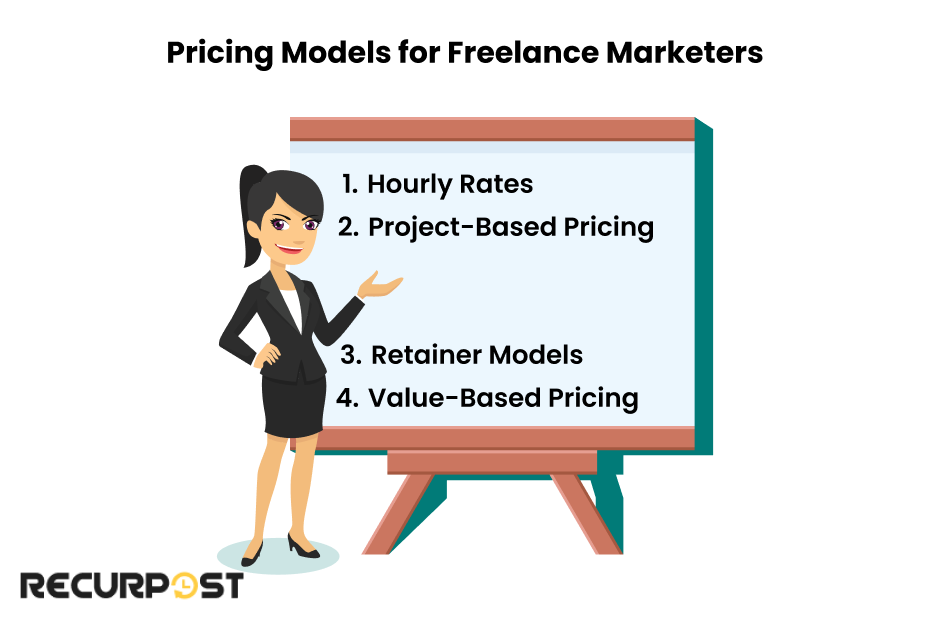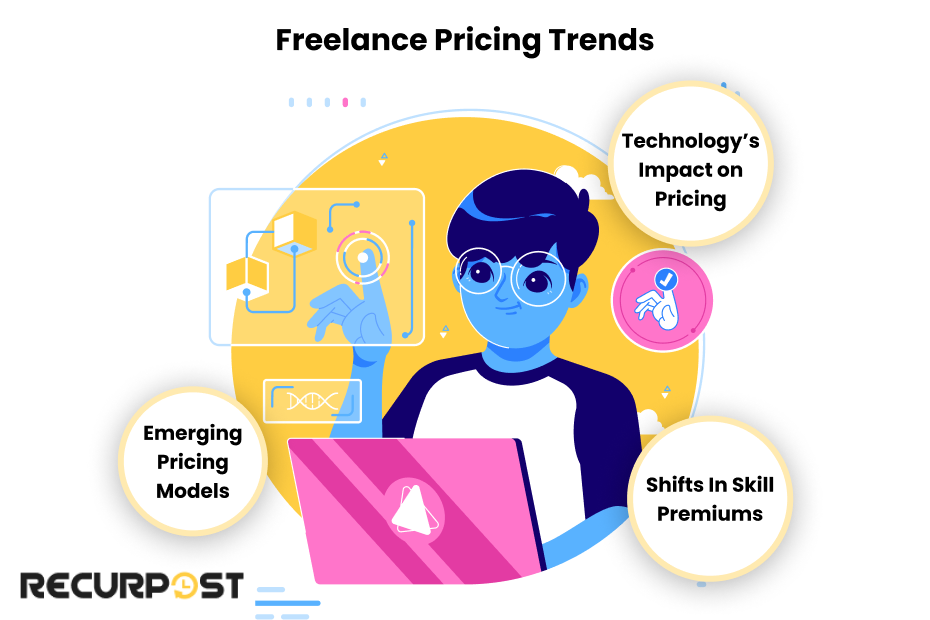Are you losing income by underpricing your freelance marketing work? In 2025, the average freelance marketer rate is $47.71 per hour (demandsage), while top performers charge much more. Do your Freelance Marketing Rates reflect your actual value in today’s market?
Key stats to consider for the freelance marketing market:
- The global freelance platform market size is projected to reach $9.19 billion by 2027, with a growth at 15.3% CAGR.
- More than 64 million Americans freelance today, with projections showing 90.1 million freelancers by 2028.
- Specialized freelancers average $28 per hour, reflecting the premium on niche expertise.
Top performers earn 3x the industry average by applying strong pricing models. This guide covers Freelance Marketing Rates, current benchmarks, and pricing trends shaping 2025.
Understanding Freelance Digital Marketing Rates
Freelance Marketing Rates for 2024-2025 vary across experience levels, skill sets, and areas of specialization.
Average Rates by Experience Level
Your experience level directly impacts your freelance marketing hourly rate. Clients pay more to marketers with proven results. Here’s a breakdown of the average freelance hourly rates by experience:
- Entry-level (0-2 years): $15-25 per hour
- Mid-level (3-5 years): $25-40 per hour
- Expert (5+ years): $50+ per hour
These figures are industry averages, not fixed standards. Unique skills, niche expertise, and results-driven work justify higher marketing rates. Experience in related fields can also position you as mid-level or expert when shifting to freelance.
Rates by Specialization
Specialized skills command higher freelance rates because they deliver measurable value. Here’s what experienced digital marketers and consultants typically earn per hour:
- Freelance Digital Marketing Consultant (Strategy Consulting): $82 per hour
- Market Research: $77 per hour
- Data Analytics: $75 per hour
- General Marketing: $62 per hour
- Graphic Designer: $45 per hour
- Writers (Content): $50 per hour
Businesses pay premium marketing rates for professionals who analyze data, deliver insights, and design impactful strategies. Upskilling in high-demand niches like data-driven marketing or conversion optimization boosts earning potential.
See our guide on social media consultant rates for detailed earnings and insights.
Service-Specific Rate Ranges
Freelance Marketing Rates also shift depending on the services offered. High-demand freelance services like SEO and full-service digital marketing command premium monthly retainers because they involve ongoing work and specialized expertise. Here’s what you can expect to charge per month:
- Full-Service Digital Marketing: $3,000-7,500
- SEO Services: $1,000-20,000 (varies by deliverables: On-page, Off-page, Technical SEO)
- PPC Management: $1,500-10,000
- Social Media Marketing: $1,000-3,000
- Content Marketing: $2,000-10,000
- Email Marketing: $200-500
For beginners, these figures serve as a benchmark for marketing rates. With more experience, credibility, and proven results, freelancers move toward the higher end of these ranges.
Advanced Tip: Position yourself as a premium freelancer in competitive markets by building case studies, gaining certifications, and offering unique freelance marketing packages. The more value you prove, the higher your freelance rates clients will accept.
Different Pricing Models for Freelance Marketers
Freelancers use several pricing models depending on services, client type, and income goals. Choosing wisely ensures your Freelance Marketing Rates reflect value and attract the right clients.

1. Hourly Rates: The Time-Based Approach
Hourly pricing means you get paid for every hour worked. This model fits:
- Short-term projects
- Consulting sessions
- Work with an undefined scope
Hourly rates are easy to calculate and explain. This model ensures payment for all billable hours, especially for ongoing projects. Clients prefer this when they pay for actual time worked.
Drawbacks include reduced earnings if you work faster, requests for detailed time logs, and a lack of alignment with the true value of your expertise.
Expert Tip: Use time-tracking tools to justify your hourly freelance rates. Detailed reports build client trust and support higher marketing rates.
2. Project-Based Pricing: Value Over Time
Project-based pricing means charging a fixed fee per project. It works well with defined deliverables and clear scopes. Clients who want budget certainty prefer this approach, especially when you can estimate costs accurately.
To estimate project costs accurately, follow a simple step-by-step process:
1. Break down the project into specific tasks
2. Estimate the time required for each task
3. Factor in your hourly rate
4. Add a buffer for unexpected work (usually 10-20%)
5. Consider the project’s value to the client
Typical project-based pricing ranges:
- Small projects: $500–$2,500
- Medium projects: $2,500–$10,000
- Large projects: $10,000–$100,000+
Strategy: Use tiered project pricing. Offer Basic, Standard, and Premium freelance marketing packages with clear distinctions to meet different budgets.
3. Retainer Models: Steady Income, Long-Term Relationships
Retainers provide predictable income and stable client relationships. Clients pay set fees for ongoing services, giving you consistent work and financial stability. This benefits freelancers who prefer long-term partnerships over constantly acquiring new projects.
There are two main types of retainers. Time-based retainers mean the client pays for a set number of hours per month, while deliverable-based retainers focus on specific outputs, like a certain number of blog posts or social media posts and updates.
When it comes to pricing, retainers typically fall into these ranges:
- Basic: $500–$1,000 per month
- Standard: $1,000–$5,000 per month
- Premium: $5,000–$10,000+ per month
Want to justify higher retainer fees? Offer value-added bonuses. This could be quarterly strategy sessions, priority support, or even exclusive access to research and tools. Small perks like these can make your offer more appealing and help you land higher-paying clients.
4. Value-Based Pricing: The High-Premium Strategy
Value-based pricing charges based on impact rather than hours worked. This model works for high-impact projects with clearly measurable results. Freelancers with proven track records significantly boost earnings through this approach.
To implement value-based pricing:
1. Understand the client’s goals and the potential impact of your work
2. Quantify the value in financial terms (e.g., increased revenue, cost savings)
3. Set your price as a percentage of that value (typically 10-30%)
Breaking Down Average Freelance Marketing Rates by Specialization
Knowing current freelance social media manager rates helps position services competitively. Freelance Marketing Rates also vary by specialization, experience, geographic location, and client type:
Experience and Expertise Matter
Experience correlates with higher freelance rates. Industry tenure, niche expertise, and recognition justify premium pricing. Specialized skills like AI-driven marketing and data analysis push rates higher.
Clients pay more for specialists with measurable results. Knowing your target audience and tailoring services helps set freelance marketing rates that reflect value delivered.
Market Factors That Affect Your Rates
Geographic location affects freelance marketing pricing. New York City freelancers charge more than smaller markets. Industry demand matters: fast-growth sectors support higher marketing consultant rates, while oversaturated niches lower them.
Freelancers with unique skills still command top dollar. Self-employed professionals must track freelance market trends in 2025 to adjust pricing and remain competitive.
Project Scope and Complexity
Project scope impacts costs. Complex projects and urgent deadlines increase rates. Work requiring specialized tools or software also raises freelance marketing rates.
Tip: Always include a scope creep clause in contracts. It protects you from unpaid tasks and keeps freelance project pricing transparent.
Client Type and Industry-Specific Pricing
Client type affects pricing. Small businesses keep standard budgets, while enterprise clients pay 40–100% more. Industry variations exist: luxury brands pay 25–50% higher, while tech/SaaS companies pay 20–35% higher digital marketing freelance rates.
Expert tip: Tailor proposals to industries. Showing the unique value you deliver helps justify higher freelance consulting rates and increases profitability.
Effective Packaging Strategies for Freelance Marketing Services

Well-structured freelance marketing packages help freelancers boost earnings. These packages make Freelance Marketing Rates easier to present and justify to clients.
Offer Tiered Service Packages
Offer clients flexible freelance pricing options that suit different budgets. A tiered structure works best:
- Foundation Package: A great starting point with basic setup and essential services. Priced between $1,000-$3,000 per month, this is ideal for small businesses and startups.
- Growth Package: Includes enhanced services and strategic planning. With a price range of $3,000-$7,000 per month, this package suits growing businesses and established brands.
- Transformation Package: A premium, full-service option with consulting and support. $7,000–$15,000+ per month, ideal for large enterprises with complex projects.
This tiered model gives clients a choice while ensuring fair freelance marketing rates for your expertise.
Bundle Complementary Services
Bundle related services to provide more value while increasing revenue. Consider offering services in bundles like:
✔️ Social media management + content creation + paid advertising
Price bundled services by:
1. Calculate the total cost of individual services.
2. Apply a small discount (typically 10-20%) to make the bundle more appealing.
3. Ensure the final price still maintains a healthy profit margin for you.
Bundled freelance services pricing makes it easier for clients to invest in multiple solutions at once.
Create Niche-Specific Packages
Creating niche-specific freelance marketing packages helps attract high-paying clients.
For example:
- An e-commerce marketing package tailored to online stores
- A B2B marketing freelancer package designed for companies relying on high-value clients
- Social Media Management Packages for businesses of all sizes
Build an effective niche package by:
1. Research industry-specific challenges and goals.
2. Align your services to solve those pain points.
3. Price your package based on the specialized value you bring.
4. Promoting expertise in marketing materials to build credibility
A niche focus positions you as an expert, helping justify higher freelance consulting rates and attracting premium clients.
Setting and Communicating Your Rates: Pro Tips for Success
Set Freelance Marketing Rates based on the value you deliver. Businesses invest in freelancers who produce measurable results and strong ROI.
Research Your Market Before Setting Rates
Always research freelance marketing rates before finalizing your pricing. Understanding competitor freelance rates ensures competitiveness and builds confidence.
Use resources like Glassdoor, PayScale, and industry reports to check earnings. Communities like freelance marketing rates on Reddit also share candid insights on what other freelancers charge.
Run anonymous client surveys to gauge budget expectations. Stay ahead of freelance market trends 2025 by joining associations and attending industry events.
Tip: Use anonymous surveys to validate marketing consultant rates. They provide insights into what clients are actually willing to pay.
Calculate Your Minimum Acceptable Rate (MAR)
Your Minimum Acceptable Rate (MAR) is the lowest hourly rate meeting your financial goals.
Calculate it by:
1. Set your annual income goal
2. Add your business expenses (software, marketing, training, etc.)
3. Factor in taxes
4. Divide by your billable hours per year
For example:
- Annual income goal: $80,000
- Business expenses: $10,000
- Taxes (30%): $27,000
- Total needed: $117,000
- Billable hours per year: 1,040 (assuming 20 hours/week)
- MAR = $117,000 ÷ 1,040 = $112.50 per hour
Revisit your MAR as your business grows to ensure your monthly income meets financial goals.
The Psychology of Pricing
Pricing is influenced by perception as much as numbers. Client psychology impacts freelance marketing pricing strategies.
- Avoid underpricing: Low rates can make your services seem less valuable.
- Use odd numbers: Prices like $997 feel more calculated than a round $1,000.
- Anchor high: Start with a higher rate so your actual price seems more reasonable.
Mastering Negotiation Strategies
A professional freelance rate card or hourly sheet helps communicate value. Negotiation strategies secure higher-paying clients and fair freelance consulting rates.
- Start high to leave room for negotiation.
- Focus on value, not price, highlight the ROI and results you deliver.
- Be willing to walk away if the client’s budget doesn’t meet your MAR.
- Offer alternative solutions before lowering your rate, like reducing the project scope or extending the timeline.
Tip: Offer discounts strategically: upfront payments or long-term commitments work better than cutting your freelance marketing rates outright.
Platform-Specific Pricing Strategies for Freelance Marketers
Freelance platforms shape pricing with unique dynamics. Understanding these systems helps you set Freelance Marketing Rates that stay competitive and boost earnings.
Pricing on Major Freelance Platforms
Each platform has different pricing models and client expectations. Here’s how freelancers set freelance rates on top platforms:
Upwork: Clients compare many proposals. Balance competitiveness with profitability. Factor in the 10% service fee. If your target hourly rate is $50, quote $55–60 to cover fees.
Freelancer.com: A price-sensitive platform where clients often choose the lowest bids. To stay competitive, focus proposals on ROI and measurable results, not just low pricing.
Fiverr: Works best for packaged freelance marketing services. Start with competitive base rates to build reviews, then raise prices as credibility grows.
Adjusting for Platform Commission Structures
Adjust rates to account for platform fees:
- 5% platform fee: Add 5-7% to your standard rate
- 10% platform fee: Add 10-15% to your standard rate
- 20% platform fee: Add 20-25% to your standard rate
Building Competitive Positioning Within Marketplaces
Success requires more than competitive rates. Strengthen your freelance market positioning by:
1. Starting with lower rates to gather initial reviews and build platform credibility
2. Gradually increasing rates as your profile strengthens (typically every 10-15 completed projects)
3. Showcasing specialized skills that justify higher digital marketing freelance rates
4. Responding quickly to project invitations, as platform algorithms often favor active freelancers
Platform Strategy Tip: Many freelancers use a graduation approach: begin on competitive platforms, then shift to premium ones as skills, reviews, and portfolios grow.
Future Trends in Freelance Marketing Pricing (2025 and Beyond)
Emerging trends shaping Freelance Marketing Rates in 2025 and beyond include new pricing models, evolving skills demand, and technology’s impact.

Emerging Pricing Models
Beyond hourly and project-based pricing, freelancers now adopt performance-based pricing, linking income to results like cost per lead or ROI. Subscription models are rising, with recurring monthly fees. Hybrid pricing combines base retainers with performance bonuses, balancing stable income and incentive-driven growth.
Technology’s Impact on Pricing
Technology reshapes freelance marketing pricing. AI and automation reduce execution work, making strategy more valuable. Platforms shape standards while taking commissions. Blockchain and smart contracts may streamline payments and protect freelancers.
Shifts in Skill Premiums
Changing demand shifts skill premiums. Data analytics, AI integration, and privacy-first marketing command higher freelance rates. Omnichannel strategy remains a premium skill for digital marketers.
Position yourself for premium freelance consulting rates by:
1. Continuously upskill in emerging technologies and methodologies
2. Develop a strong personal brand as a thought leader in your niche
3. Focus on delivering and documenting measurable results for prospective clients
4. Aligning pricing with your annual income goal for long-term stability
Final Thoughts
Setting fair Freelance Marketing Rates blends judgment with calculation. Rates showcase your value in the market. Pricing reflects skill, experience, and results. Confident freelance pricing drives career growth.
Are you ready to take your Freelance Marketing Rates to the next level? Review your current freelance pricing strategy and spot improvements. Future success starts with the rates you set now!
FAQs on Freelance Marketing Rates
1. How do I know if my rates are competitive?
Compare your Freelance Marketing Rates with industry benchmarks. Check what other freelancers charge and factor in your skills. If clients accept too quickly, you may be under your minimum acceptable rate (MAR).
2. Should I publish my rates on my website?
It depends on your strategy. Listing your hourly freelance rate can attract serious clients and save time, but keeping it private allows for flexibility based on project needs.
3. What is the best pricing model for beginners?
Hourly pricing is a great start since it ensures you’re paid for your time. As you gain experience and take on more freelance jobs, you can transition to project-based or value-based pricing.
4. How do I increase my rates without losing clients?
Give existing clients a heads-up, highlight the added value you bring, and consider a gradual increase. Many clients will pay more money for quality and consistency.
5. Are value-based pricing models suitable for all clients?
Not always. Value-based pricing works best with clients who understand ROI and long-term benefits. Some may prefer fixed rates, so adjust your approach based on the client. If you’re unsure how to price your freelance projects competitively, checking how a digital marketing agency structures its pricing can give you valuable insights.
6. Is freelancing service good, or should I pick agencies?
Both freelancing services and agencies have their pros and cons. If you need specialized skills at a lower cost, freelancers can be a great choice. However, if you’re looking for a full-service solution with consistent quality, a real estate marketing agency or an agency for social media marketing might be a better fit. Agencies offer a team of experts, structured strategies, and access to the best digital marketing agency websites for advanced tools and insights, making them ideal for long-term growth.
7. How do you handle pricing when clients want multiple services bundled together?
Create custom freelance packages instead of stacking rates. This stays competitive and covers time. Example: combine SEO freelance rates with monthly social content under one retainer.
8. How should you price short-term or one-off email marketing projects?
For quick email campaigns or single automation flows, it’s best to charge by the hour or set a flat rate based on estimated hours. The average email marketing freelancer hourly rate 2025 ranges between $40 to $85, so use that as a benchmark while factoring in your expertise and turnaround time.
9. Should you adjust your rates based on the client’s industry or business size?
Yes, and smart freelancers often do. Larger businesses may have bigger budgets and more complex needs, which justifies quoting higher freelance marketing consultant rates. Always assess the value you’re providing and align your pricing with the client’s potential ROI.

Shalini Nagar is an experienced content writer with a proven track record of creating diverse and engaging content across various formats. With years of expertise in crafting blogs, articles, she excels at delivering compelling narratives tailored to different audiences.





